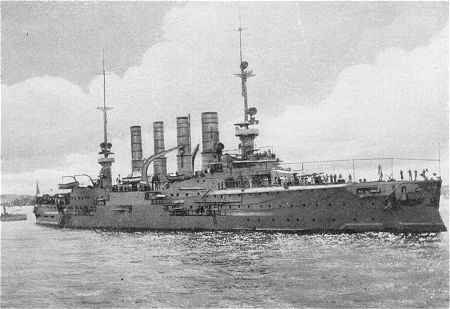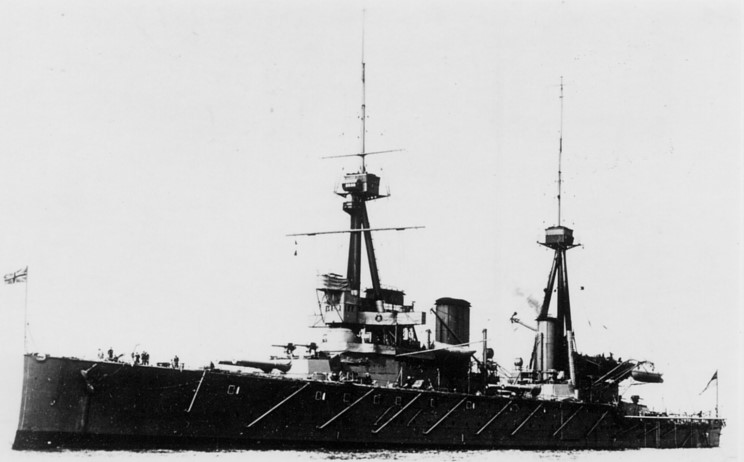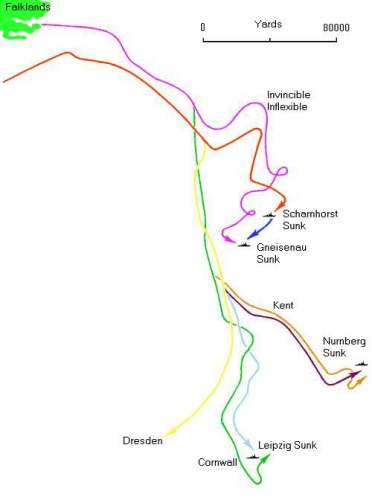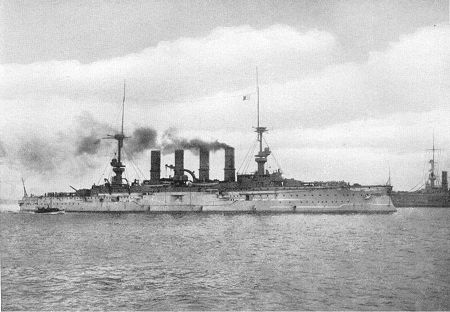|
BATTAGLIE NAVALI DI CORONEL E FALKLAND NAVAL BATTLES OF CORONEL AND FALKLAND'ISLANDS (NOVEMBRE - DICEMBRE 1914) L'ULTIMA CROCIERA DELL'AMMIRAGLIO SPEE (TRATTO DA ARTICOLI DEL PROF. FRANCESCO LAMENDOLA - ARIANNA EDITRICE) |
||||||||||||||||||||||||||||||||||
|
|
|
|||||||||||||||||||||||||||||||||
|
LA BATTAGLIA NAVALE DELLE ISOLE FALKLAND (08.12.1914) NAVAL BATTLE OF FALKLAND'S ISLANDS (08.12.1914) (Tratto da articoli gentilmente concessi dal Prof. FRANCESCO LAMENDOLA) FORZE IMPEGNATE
STORIA All'alba dell'8 dicembre, la squadra di von Spee si stava avvicinando a Port Stanley da nord-est; alle 5 del mattino il Gneisenau ed il Nürnberg si staccarono dal grosso e si spinsero innanzi per effettuare una ricognizione; a bordo del primo, un distaccamento di truppe da sbarco era già in assetto di combattimento per impadronirsi della cittadina.. Fu allora che i Tedeschi videro, al di sopra del porto, svettare le caratteristiche alberature a tripode delle "dreadnoughts" e quelle di parecchi altri incrociatori. Informato per mezzo del radiotelegrafo, l'ammiraglio Spee ordinò alle sue due navi di ricongiungersi subito al resto della squadra. Egli non sapeva ancora esattamente quale fosse l'entità delle forze avversarie presenti a Port Stanley; tuttavia, fidando nella velocità delle sue navi e nell'ottimo stato delle macchine, egli pensava di poter far perdere rapidamente le proprie tracce. Molto probabilmente, si trattò di un errore clamoroso, l'ultimo di una lunga serie: i suoi incrociatori non avrebbero mai potuto competere in velocità con le navi del tipo "dreadnought" e, come se ciò non bastasse, si annunciava una giornata bellissima, con cielo limpido e sgombro: circostanza veramente eccezionale a quelle latitudini, dove il maltempo è praticamente la regola. Meglio sarebbe stato non tentare nemmeno il colpo sulle Falkland; ma, una volta presa la decisione, tanto valeva spingere l'audacia sino in fondo e lanciare l'attacco immediatamente, mentre le navi inglesi erano in porto a motori spenti e impegnate nelle operazioni di carico del carbone. Certo, la maggior gittata dell'Invincible e dell'Inflexible escludeva che tale manovra si potesse effettuare senza rischi: per poterle colpire, von Spee avrebbe dovuto portarsi a sua volta al di qua della distanza di sicurezza. Tuttavia avrebbe goduto del vantaggio incomparabile di poter manovrare liberamente, contro un avversario immobile e impacciato, oltre che dalle operazioni di carbonamento, dal ristretto spazio in cui avrebbe dovuto manovrare per uscire dal porto. Insomma, confrontando rischi e benefici, appare evidente che l'attacco sarebbe stato la migliore difesa (senza parlare dell'effetto psicologico); mentre la fuga, col mare calmo e l'aria limpidissima, offriva ben poche speranze di salvezza. Si ricorderà come sia l'Emden nell'incursione di Penang, sia il Königsberg in quella nel porto di Zanzibar, avevano potuto sfruttare appunto, oltre che il fattore sorpresa, la temporanea impotenza delle navi nemiche presenti in rada; analogo successo avrebbe potuto toccare a von Spee, se egli avesse raccolto la sfida del destino e trasformato in elemento di vantaggio l'incontro inaspettato con la poderosa squadra britannica, avendola sorpresa nella circostanza per essa meno favorevole. L'unico elemento che può spiegare la clamorosa decisione dell'ammiraglio tedesco di ripiegare è che il comandante del Gneisenau, nonostante il parere contrario di alcuni suoi ufficiali, non credette di ravvisare nei fumaioli e nelle alberature delle navi presenti in rada un indizio certo della presenza di "dreadnoughts", e - come pare - omise di segnalare al suo superiore tale decisiva circostanza (cfr. E. Bravetta, La grande guerra sul mare, vol. 1, Milano, 1926, p. 144).
Sturdee ordinò di mettere immediatamente le caldaie sotto pressione e già verso le 10 del mattino le sue navi cominciavano ad uscire dal porto, mettendosi all'inseguimento. A bordo delle navi tedesche ci si rese conto, poco tempo dopo, di avere a che fare con degli incrociatori da battaglia e che la fuga, pertanto, era vana. Verso mezzogiorno l'Invincible - nave ammiraglia di Sturdee - e l'Inflexible filavano a 17 km. sulla sinistra della squadra tedesca, a sud-est di Port Stanley; li seguivano gli incrociatori corazzati Carnarvon, Cornwall, Kent e l'implacabile Glasgow, il cui comandante si era prodigato fino all'ultimo perché la caccia avesse inizio senza perdere un solo istante prezioso. Un altro incrociatore leggero, il Bristol, era rimasto attardato in porto. Portatisi a una velocità di 26 nodi, alle ore 13 gli incrociatori da battaglia aprirono il fuoco cui rispose, poco dopo, lo Scharhnorst. A questo punto von Spee, rendendosi conto dell'inutilità di tenere con sé le navi leggere e sperando che almeno esse, più veloci, sarebbero riuscite a fuggire, distaccò il Leipzig, il Nürnberg e il Dresden perché tentassero di fuggire per proprio conto, magari sfruttando qualche nuvola portatrice di pioggia: ma l'orizzonte rimaneva ostinatamente limpido e sgombro.
La lotta degli incrociatori corazzati tedeschi appariva senza speranza: il peso complessivo di una bordata dello Scharnhorst e del Gneisenau era di meno di 1.600 kg., mentre quello di una bordata dell'Invincible e dell'Inflexible era di oltre 4.500 kg. Nonostante l'enorme disparità di forze, la battaglia durò a lungo. Comportandosi con estrema prudenza, le navi di Sturdee continuavano a sparare tenendosi a grande distanza. Allora le due navi tedesche volsero la prua verso il nemico e, ridotte le distanze, incominciarono a colpire l'avversario con precisione infallibile. Ciò indusse gli incrociatori da battaglia ad allontanarsi nuovamente; certo ormai della vittoria, il comandante inglese non volle esporre le sue navi al fuoco nemico. A quel punto gli incrociatori corazzati di von Spee virarono nuovamente di bordo e tentarono di allontanarsi, ma subito le navi inglesi ripresero l'inseguimento e, alle 14,30, il combattimento ricominciò. Di nuovo le granate tedesche da 220 mm ripresero a cadere con precisione infallibile sulle navi britanniche, ma senza riuscire a penetrare le loro robuste corazze; invece le granate di 305 mm infliggevano agli incrociatori corazzati danni sempre più gravi. Nonostante tutto, questi ultimi continuarono a lottare fino all'estremo con una meravigliosa precisione di tiro finchè, alle 16,17, lo Scharnhorst s'inabissò con l'ammiraglio von Spee e con tuttto l'equipaggio. Prima di sparire tra i flutti esso aveva fatti in tempo a sparare un ultimo colpo dalla torretta anteriore, già quasi lambita dalle onde, le eliche sollevate e la poppa sprofondata. Il Gneisenau, immobilizzato dai colpi, crivellato, attaccato non solo dall'Invincible e dall'Inflexible ma anche dal Carnarvon, combattè ancora a lungo, senza mai arrendersi. Alle 18,02 si capovolse e affondò, con gran parte dell'equipaggio; solo 187 uomini, fra i quali il comandante in seconda Pochhammer, vennero tratti in salvo dalle gelide acque sub-antartiche. La fortuna abbandonò anche gli incrociatori leggeri tedeschi. Il Nürnberg affondò alle 19,27 dopo aver lottato valorosamente contro il Kent ed essere riuscito a colpirlo circa 40 volte; solo 10 marinai tedeschi vennero salvati. Anche il Leipzig, inseguito dal Cornwall e dal Glasgow, lottò fino all'estremo: affondò alle 20,35 e solo 18 uomini vennero tratti in salvo. Soltanto il Dresden, grazie alla sua maggiore velocità e a un piovasco provvidenziale, riuscì a fuggire: dopo una magnifica giornata, il mare si era fatto nuovamente grosso (aumentando le difficoltà per il salvataggio dei naufraghi, assaliti anche dai grandi albatri) e il vento stava portando la pioggia, inutilmente attesa da von Spee. Non sfuggirono all'affondamento neppure le navi da carico Baden e Santa Isabel, che vennero colate a picco dal ritardatario Bristol e dall'incrociatore ausiliario Macedonia. Oltre al Dresden, l'unica nave tedesca che riuscì a far perdere le sue tracce fu il piroscafo Seydlitz; esso venne catturato più tardi sulle coste dell'Argentina. Il Dresden riuscì a tenersi nascosto per circa tre mesi nell'Isola Nera, un ancoraggio segretissimo nel dedalo di baie e canali della Terra del Fuoco; finchè, a corto di combustibile, venne scoperto e attaccato da incrociatori inglesi presso la Baia di Cumberland nell'isola di Mas a Tierra, il 15 marzo 1915 - a dispetto del fatto che si trovava in acque territoriali cilene e, quindi, neutrali. Il comandante del Dresden preferì autoaffondare l'incrociatore, il cui equipaggio venne internato sino alla fine della guerra. Complessivamente, nella battaglia delle Isole Falkland su un effettivo di 2.200 uomini dei 4 incrociatori tedeschi, solo 215 marinai e ufficiali scamparono alla morte.
Si trattò di uno scontro importante perché ristabilì il controllo dell'Intesa sulle rotte oceaniche e allontanò il pericolo dall'arteria vitale del Rio della Plata. Non fu però un atto d'armi glorioso per l'ammiraglio Sturdee, né vi ebbe parte la sua perizia strategica: l'incontro col nemico fu dovuto a un colpo di fortuna e, a partire da quel momento, l'esito fu scontato. Nel corso della battaglia i puntatori tedeschi confermarono la loro netta superiorità, mentre agli Inglesi furono necessarie circa sette ore per aver ragione di un avversario nettamente inferiore per potenza e velocità. Inoltre la vittoria fu incompleta, poiché la fuga del Dresden costrinse l'Ammiragliato di Londra a tener vincolato un discreto numero di navi nella regione magellanica per dargli la caccia, proprio come accadde con il Königsberg nel delta africano del Rufigi. Lo sconfitto di Coronel, l'ammiraglio Cradock, aveva dimostrato ben altra tempra ed altro valore che non Sturdee, il vincitore delle Falkland.. Gli emigranti tedeschi del Cile eressero un piccolo monumento funebre, a Valparaiso, in ricordo dei caduti della sfortunata squadra di von Spee. Ormai, la presenza navale tedesca era stata eliminata dagli oceani; per tentar di interrompere il traffico commerciale alleato nell'Oceano Atlantico, non restava alla Germania che l'arma sottomarina. Essa diede risultati notevoli, ma finì per trascinare in guerra gli Stati Uniti d'America e, con ciò, provocò l'inizio della fine per gli Imperi Centrali. Ma quello fu un altro capitolo della prima guerra mondiale sui mari, che fu caratterizzato da condizioni materiali e spirituali completamente diverse; e, purtroppo, da un contesto in cui le gesta cavalleresche di un von Müller non erano che un lontano ricordo. NAVAL BATTLE OF FALKLAND'S ISLAND (08.12.1914) To the dawn of December 8, the team of von Spee he was approaching to Port Stanley from northeast; to the 5 of the morning the Gneisenau and the Nürnberg detached him from the big one and they pushed from now on him to effect a recognition; on board of the first one, a detachment of unloading troops was already in order of fight to appropriate of the town. It was then that the Germans saw, above the I bring, to poll the characteristics tripod masting of the "dreadnoughts" and those of quite a lot other cruisers. Informed through the I wireless, the admiral Spee ordered to his/her two ships immediately to rejoin him to the rest of the team. He didn't exactly know still what pits the entity of the strengths present avversarie to Port Stanley; nevertheless, entrusting in the speed of his/her ships and in the good state of the cars, he thought about being able to make to quickly lose his/her own traces. It very probably dealt with a resounding error the last of a long series,: its cruisers would never have been able to compete in speed with the ships of the type "dreadnought" and, as if this was not enough, a very beautiful day was announced, with clear and clear of sky: really exceptional circumstance to those latitudes, where the maltempo is practically the rule. It would have been better not to even try the hit on the Falklands; but, once taken the decision, so much was worth to push after all the audacity until and to immediately launch the attack, while the ships English were in I bring to motor out and busy in the operations of load of the coal. Certainly, the most greater range of the Invincible and the Inflexible excluded that such manoeuvre could be effected without risks: to be able to strike her, von Spee would have had to go in turn himself/herself/themselves to the of of the safety distance here. Nevertheless you/he/she would have enjoyed some incomparable advantage to be able to freely maneuver, against an immovable and embarrassed adversary, over that from the operations of carbonamento, from the narrow space in which you/he/she would have had to maneuver for going out of the I bring. In short, comparing risks and benefits, it appears evident that the attack would have been the best defense (without speaking of the psychological effect); while the escape, with the calm sea and the clear air, it offered well few hopes of salvation. You will remember as is the Emden in the raid of Penang, is the Königsberg in that in the I bring of Zanzibar, they had been able to exploit note, over that the factor surprise, the temporary impotence of the present hostile ships in roadstead; analogous success would have been able to touch to von Spee, if he had picked up the challenge of the destiny and turned into element of advantage the unexpected meeting with the mighty British team, having it surprise in the circumstance for it less favorable. The only element that can explain the resounding decision of the German admiral to refold is that the commander of the Gneisenau, despite the opinion contrary of some officers of his, not credette to recognize in the chimneys and in the masting of the present ships in roadstead a certain sign of the presence of "dreadnoughts", and - as it seems - it omitted to signal such decisive circumstance to its superior (cfr. E. Bravetta, You great war on the sea, vol. 1, Milan, 1926, p. 144). Sturdee ordered to immediately put the calaies under pressure and already toward the 10 of the morning its ships started to go out of the I bring, putting himself/herself/itself to the pursuit. To bodo of the German ships him made account, little time later, to have to whether to make with some battle cruisers and that the escape, therefore, was vain. Toward midday the Invincible - flagship of Sturdee - and the Inflexible they spun to 17 kms. on the left of the German team, southeast of Port Stanley; the armored cruisers Carnarvon, Cornwall, Kent and the implacable Glasgow followed them, whose commander was lavished up to the last one because hunting had beginning without losing only a precious instant. Another light cruiser, the Bristol, had remained lingered in I bring. Brought him to a speed of 26 knots, at 1 pm the battle cruisers opened the fire which answered, shortly after, the Scharhnorst. To this point von Spee, account of the uselessness making itself to hold with itself the light ships and hoping that at least them, faster, you/they would have succeeded in running away, it detached the Leipzig, the Nürnberg and the Dresden because they tried to run away for really account, even exploiting some cloud pluvius bearer: but the horizon was obstinately clear and clear of. The struggle of the cruisers armored German appeared without hope: the general weight of a broadside of the Scharnhorst and the Gneisenau was less of 1.600 kgs., while that of a broadside of the Invincible and the Inflexible was of over 4.500 kgs. Despite the enormous disparity of strengths, the battle lasted for a long time. Behaving himself/herself/itself with extreme prudence, the ships of Sturdee they kept on shooting holding himself/herself/itself to great distance. Then the two German ships turned the bow toward the enemy and, reduced the distances, they began to strike the adversary with infallible precision. This induced the battle cruisers to again get further; certain by now of the victory, the commander English didn't want to expose its ships to the hostile fire. To that point the cruisers armored of von Spee again veered of edge and they tried to get further, but immediately the ships English took back the pursuit and, at 14,30 o'clock, the fight restarted. Again the German brooms from 220 mms started over falling with infallible precision on the British ships, but without succeeding in penetrating their strong caresses; instead the brooms of 305 mms inflicted more and more armored serious damages to the cruisers. Despite everything, these last ones kept on fighting up to the extreme with a marvelous precision of draught until, at 16,17 o'clock, the Scharnhorst was sunk with the admiral von Spee and with tuttto the crew. Before disappearing among the billows it had done in time to shoot a last hit from the anterior turret, already almost licked up by the waves, the lifted helixes and the sunk stern. The Gneisenau, immobilized by the hits, riddled, attached not only from the Invincible and from the Inflexible but also from the Carnarvon, he/she fought for a long time still, without never surrendering himself/herself/themselves. At 18,02 o'clock it overturned and it sank, with big part of the crew; only 187 men, among which the commander in second Pochhammer, was drawn in safe by the icy sub-Antarctic waters. Fortune also abandoned the German light cruisers. The Nürnberg sank at 19,27 o'clock after having bravely fought against the Kent and being succeeded in striking him/it around 40 times; only 10 German sailors were saved. Also the Leipzig, pursued from the Cornwall and from the Glasgow, it fought up to the extreme: it sank at 20,35 o'clock and only 18 men were saved. Only the Dresden, thanks to his/her greater speed and a providential squall, he/she succeeded in running away: after a magnificent day, the sea was again made big (increasing the difficulties for the rescue of the is shipwrecked, also attacked by the great albatrosses) and the wind was bringing the rain, uselessly attended by von Spee. They didn't even escape the sinking the load ships Baden and Saint Isabel, that was strained to peak by the late comer Bristol and from the cruiser auxiliary Fruit salad. Besides the Dresden, the only German ship that succeeded in making to lose its traces was the steamboat Seydlitz; it was captured later on the coasts of Argentina. The Dresden succeeded in holding him hidden for around three months in the Black island, a secret anchorage in the maze of bays and channels of the Earth of the Fire; until, to short of fuel, you/he/she was discovered and attached by cruisers English near the Bay of Cumberland in the island of Mas to Tierra, March 15 th 1915 - in spite of the fact that was found in Chilean territorial waters and, therefore, neutral. The commander of the Dresden preferred autoaffondare the cruiser, whose crew was actually interned at the end of the war. Altogether, in the battle of the Islands Falkland on a strength of 2.200 men of the 4 German cruisers, only 215 sailors and officers escaped to the death. It dealt with an important clash because it reestablished the control of the agreement on the oceanic routs and it estranged the danger from the vital artery of the Rio of the Plata. It was not however a glorious action of weapons for the admiral Sturdee, neither part its strategic skill had you: the meeting with the enemy was due to a stroke of luck and, beginning from that moment, the result was discounted. During the battle the German pointers confirmed their clean superiority, while to the English they were necessary around seven hours to clearly be right for an inferior adversary for power and speed. Besides victory was incomplete, since the escape of the Dresden forced the admiralty in London to bound tener a discreet number of ships in the region magellanica to chase him the, just as it happened with the Königsberg in the African delta of the Rufigi. Defeats him/it of Coronel, the admiral Cradock, you/he/she had shown well other tempering and other value that not Sturdee, the winner of the Falklands.. The German emigrants of Chile erected a small funeral monument, to Valparaiso, in memory of the fallen ones of the unlucky team of von Spee. By now, the German naval presence had been eliminated by the oceans; for tentar to interrupt the allied commercial traffic in the Atlantic ocean, it didn't stay to Germany that the submarine weapon. It gave notable results, but it ended up dragging in war the United States of America and, with this, it provoked the beginning of the end for the Central Empires. But that was another chapter of the first world war on the seas, that you/he/she was characterized by completely different material and spiritual conditions; and, unfortunately, from a context in which the chivalrous deeds of a von Müllers were not that a far memory. LE PIU' GRANDI BATTAGLIE NAVALI /NAVAL BATTLE |
||||||||||||||||||||||||||||||||||




